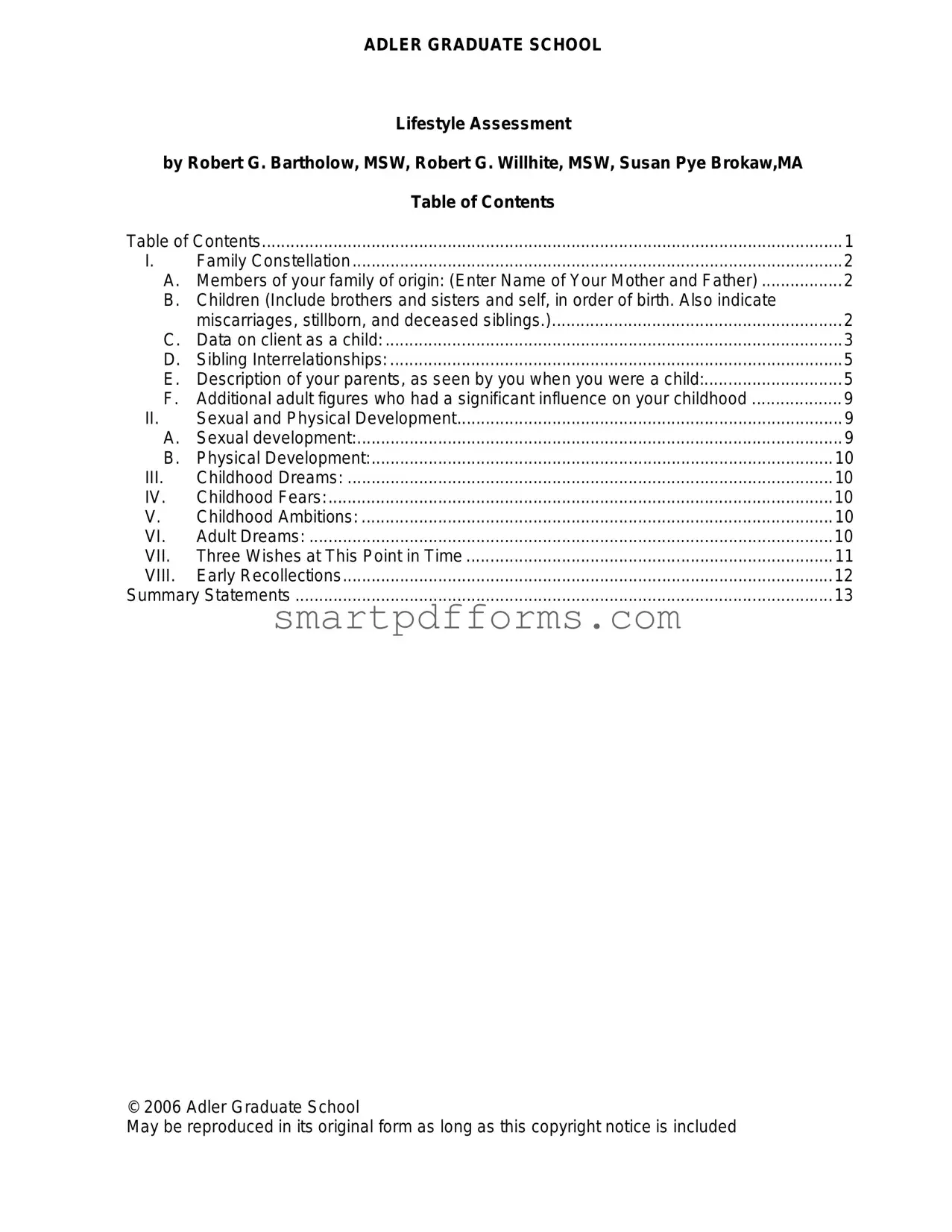ADLER GRADUATE SCHOOL
|
Lifestyle Assessment |
|
by Robert G. Bartholow, MSW, Robert G. Willhite, MSW, Susan Pye Brokaw,MA |
|
|
Table of Contents |
|
Table of Contents |
1 |
I. |
Family Constellation |
2 |
A. |
Members of your family of origin: (Enter Name of Your Mother and Father) |
2 |
B. |
Children (Include brothers and sisters and self, in order of birth. Also indicate |
|
|
miscarriages, stillborn, and deceased siblings.) |
2 |
C. |
Data on client as a child: |
3 |
D. |
Sibling Interrelationships: |
5 |
E. |
Description of your parents, as seen by you when you were a child: |
5 |
F. |
Additional adult figures who had a significant influence on your childhood |
9 |
II. |
Sexual and Physical Development |
9 |
A. |
Sexual development: |
9 |
B. |
Physical Development: |
10 |
III. |
Childhood Dreams: |
10 |
IV. |
Childhood Fears: |
10 |
V. |
Childhood Ambitions: |
10 |
VI. |
Adult Dreams: |
10 |
VII. |
Three Wishes at This Point in Time |
11 |
VIII. |
Early Recollections |
12 |
Summary Statements |
13 |
© 2006 Adler Graduate School
May be reproduced in its original form as long as this copyright notice is included
Adler Graduate School
Lifestyle Assessment
Client’s Name
Date
Therapist
I.Family Constellation
A. Members of your family of origin:
Name
B.Children (Include brothers and sisters and self, in order of birth. Also indicate miscarriages, stillborn, and deceased siblings.)
Insert Genogram below
Adler Graduate School
Lifestyle Assessment
Give childhood descriptions of each child, in birth order, including self
C.Data on client as a child:
1Who was most like you? In what ways?
2Who was most different from you?
In what ways?
3Grade school information:  Attitude?
Attitude?
Favorite subject? Least liked subject? Social situation? Teachers pet?
4Sports interests or skills?
5Childhood habits?
6When a child, who had health problems, physical or emotional?
7* |
As a child, did you feel |
|
|
that boys or girls had |
|
|
advantages over the |
|
|
other? |
|
|
|
Revised 1/2006 |
3 |
|
Adler Graduate School |
|
|
|
|
|
Lifestyle Assessment |
|
|
|
|
|
|
|
|
|
|
|
|
8* |
If a female, were you a |
|
|
|
|
|
|
|
tomboy in childhood? |
|
|
|
|
|
|
|
|
|
|
|
|
|
|
9* |
If male, did you personally |
|
|
|
|
|
|
|
think of yourself as a |
|
|
|
|
|
|
|
sissy? |
|
|
|
|
|
|
|
|
|
|
|
|
|
|
10 |
Childhood spiritual or |
|
|
|
|
|
|
|
religious experiences, if |
|
|
|
|
|
|
|
any? |
|
|
|
|
|
|
|
|
|
|
|
|
|
|
|
|
|
|
|
|
|
|
11 |
Did you, or any family |
Emotional |
|
Physical |
|
Sexual |
|
|
member(s), experience any |
|
|
|
|
|
|
|
abuse (within or outside |
|
|
|
|
|
|
|
the family)? |
|
|
|
|
|
|
|
|
Yes |
|
Yes |
|
Yes |
|
|
|
No |
|
No |
|
No |
|
|
If so: |
|
|
|
|
|
|
|
to whom? |
|
|
|
|
|
|
|
|
|
|
|
|
|
|
|
By whom? |
|
|
|
|
|
|
|
|
|
|
|
|
|
|
|
Elaborate? |
|
|
|
|
|
|
|
|
|
|
|
|
|
|
|
|
|
|
|
|
|
|
12 |
Who was most spoiled? |
|
|
|
|
|
|
|
|
|
|
|
|
|
|
|
By whom? |
|
|
|
|
|
|
|
|
|
|
|
|
|
|
|
How and for what reason? |
|
|
|
|
|
|
|
|
|
|
|
|
|
|
|
|
|
|
|
|
|
|
13 |
Who was most punished? |
|
|
|
|
|
|
|
|
|
|
|
|
|
|
|
By whom? |
|
|
|
|
|
|
|
|
|
|
|
|
|
|
|
How and for what reason? |
|
|
|
|
|
|
|
|
|
|
|
|
|
|
|
|
|
|
|
|
|
|
14 |
Who in the family needed |
|
|
|
|
|
|
|
to be right? |
|
|
|
|
|
|
|
|
|
|
|
|
|
|
15 |
Who in the family felt keen |
|
|
|
|
|
|
|
about fairness and |
|
|
|
|
|
|
|
unfairness? |
|
|
|
|
|
|
|
|
|
|
|
|
|
|
16 |
Your role in peer group? |
|
|
|
|
|
|
|
(leader, middler, follower, |
|
|
|
|
|
|
|
outsider)? |
|
|
|
|
|
|
|
|
|
|
|
|
|
|
17 |
Childhood talents or |
|
|
|
|
|
|
|
accomplishments? |
|
|
|
|
|
|
|
|
|
|
|
|
|
|
18 |
Your parent’s method of |
|
|
|
|
|
|
|
disciplining? |
|
|
|
|
|
|
|
|
|
|
|
|
|
|
Revised 1/2006 |
4 |
|
|
|
|
|
Adler Graduate School
Lifestyle Assessment
D.Sibling Interrelationships: Who took care of whom?
Who played with whom?
Who got along best with whom?
Who fought and argued most?
Who was helpful at home?
Who made mischief?
E.Description of your parents, as seen by you when you were a child:
FatherMother
Current age if living
If deceased
Age when client born
Education
Occupation
Personality: traits admired, liked, disliked, feared
What was most important to them?
What behavior or attitude could win their praise?
What made them angry?
What ways did they influence you?
What were their expectations of the children?
Adler Graduate School
Lifestyle Assessment
Description of your parents, as seen by you when you were a child: (continued)
Relationship with children?
Which child was most like them?
How?
Who were you closest to?
Were you distant from either?
Why?
In whom did you confide?
To whom did you go for comfort and support?
Why?
As a child, what kind of relationship did they have?
Who was dominant, made decisions, overt and covert?
Did they agree on discipline and raising the children?
Did they quarrel openly?
About What?
How did the quarrels end?
How did your parents solve problems
Other significant adults characteristics
Adler Graduate School
Lifestyle Assessment
Considering your answers to the above what did you learn about: Yourself?
What males are like?
What females are like?
What marriage is like?
What parenting and family life is like?
Childhood Attributes
Using the table on the next page, rate (not rank) you and your siblings from your perspective as a child. Rank only yourself and siblings who are within 5 years older or younger than yourself. Put the name of each child including yourself (in birth order) - in the box above the column. Rate those who are (H) High or (L) Low
Adler Graduate School
Lifestyle Assessment
|
|
|
|
|
|
|
|
|
|
|
|
|
|
|
|
|
|
|
|
|
|
|
|
|
|
|
|
|
|
|
|
|
|
|
|
|
|
|
|
|
|
|
|
|
|
|
|
|
|
|
|
|
|
|
|
|
|
Achieve- |
ment & |
Success |
Intelligence |
|
|
|
|
|
|
Successful |
|
|
|
|
|
|
|
Grades |
|
|
|
|
|
|
Helped at Home |
|
|
|
|
|
|
|
Industrious |
|
|
|
|
|
|
Looks |
|
|
|
|
|
|
|
Stds. Achievement |
|
|
|
|
|
|
|
|
|
|
|
|
|
|
|
|
|
|
|
|
|
|
|
|
|
|
|
|
|
|
|
|
|
|
|
|
|
|
|
|
|
|
|
|
|
|
|
|
|
|
|
|
|
Character- |
|
Tried to Please |
|
|
|
|
|
|
Moody |
|
|
|
|
|
|
|
Special |
istics |
Succeeded Pleasing |
|
|
|
|
|
|
Used Others |
|
|
|
|
|
|
|
Considerate |
|
|
|
|
|
|
Sociable |
|
|
|
|
|
|
|
Tried to be Good |
|
|
|
|
|
|
Sought Attention |
|
|
|
|
|
|
|
|
|
Selfish |
|
|
|
|
|
|
|
|
|
|
|
|
|
|
|
|
|
|
|
|
|
|
|
|
|
|
|
|
|
|
|
|
|
|
|
|
Obedient |
|
|
|
|
|
|
Critical of Others |
|
|
|
|
|
|
|
Right- |
Wrong |
|
Openly Rebelled |
|
|
|
|
|
|
Perfectionist |
|
|
|
|
|
|
|
|
Covertly Rebelled |
|
|
|
|
|
|
Tried to be Good |
|
|
|
|
|
|
|
|
Stds. Right/Wrong |
|
|
|
|
|
|
Mischievous |
|
|
|
|
|
|
|
|
|
|
|
|
|
|
|
|
|
|
|
|
|
|
|
|
|
|
Critical of Self |
|
|
|
|
|
|
|
|
|
|
|
|
|
|
|
|
|
|
Assertive |
|
|
|
|
|
|
Fighter-Scrappy |
|
|
|
|
|
|
|
Interpersonal |
Tendencies |
|
Bossy-Dominating |
|
|
|
|
|
|
Shy |
|
|
|
|
|
|
|
|
Demanded Way |
|
|
|
|
|
|
Sulked/Pouted |
|
|
|
|
|
|
|
|
Got Way |
|
|
|
|
|
|
Stubborn |
|
|
|
|
|
|
|
|
Sense of Humor |
|
|
|
|
|
|
Sensitive |
|
|
|
|
|
|
|
|
Temper |
|
|
|
|
|
|
Pitied self |
|
|
|
|
|
|
|
|
|
|
|
|
|
|
|
|
|
|
|
|
|
|
|
|
|
|
Competitive |
|
|
|
|
|
|
Held Grudges |
|
|
|
|
|
|
|
|
|
|
Idealistic |
|
|
|
|
|
|
Self Confident |
|
|
|
|
|
|
|
|
|
|
Materialistic |
|
|
|
|
|
|
Insecure |
|
|
|
|
|
|
|
|
|
|
Loner |
|
|
|
|
|
|
Neat |
|
|
|
|
|
|
|
|
Characteristics |
|
Persistent |
|
|
|
|
|
|
Gave Up Easily |
|
|
|
|
|
|
|
Attitudes & |
|
Excitement Seeker |
|
|
|
|
|
|
Dependent |
|
|
|
|
|
|
|
|
Daring |
|
|
|
|
|
|
Independent |
|
|
|
|
|
|
|
|
Complained |
|
|
|
|
|
|
Easy Going |
|
|
|
|
|
|
|
|
Responsible |
|
|
|
|
|
|
Impulsive |
|
|
|
|
|
|
|
|
Withdrawn |
|
|
|
|
|
|
Cautious |
|
|
|
|
|
|
|
|
|
|
Chip on Shoulder |
|
|
|
|
|
|
Worrier |
|
|
|
|
|
|
|
|
|
|
Punished |
|
|
|
|
|
|
Self Esteem |
|
|
|
|
|
|
|
|
|
|
Spoiled |
|
|
|
|
|
|
Inferiority Flags |
|
|
|
|
|
|
|
|
|
|
Pampered |
|
|
|
|
|
|
Hid Feelings |
|
|
|
|
|
|
|
Gender Charact- |
eristics |
|
Athletic |
|
|
|
|
|
|
|
|
|
|
|
|
|
|
|
|
Masculine* |
|
|
|
|
|
|
|
|
|
|
|
|
|
|
|
|
Feminine* |
|
|
|
|
|
|
|
|
|
|
|
|
|
|
|
|
|
|
|
|
|
|
|
|
|
|
|
|
|
|
|
|
|
|
|
|
|
|
|
|
|
|
|
|
|
|
|
|
|
|
Adler Graduate School
Lifestyle Assessment
F.Additional adult figures who had a significant influence on your childhood
Who |
Describe the |
How did it influence you? |
|
relationship |
|
|
|
|
|
|
|
|
|
|
|
|
|
II.Sexual and Physical Development
A. Sexual development:
1.When did you first notice your sexual development?
2.How did you feel about it?
3.Were you prepared for it?
4.If female - when did you first start menstruation? How did you feel about it?
Were you prepared for it?
Have you had any menstrual difficulties?
Have you had any prenatal or postnatal difficulties?
*5. If a boy, were you told you should have been a girl?
*6. If a girl, were you told you should have been a boy?
Adler Graduate School
Lifestyle Assessment
7.Review all 7 starred (*) items for additional gender issues
8.As an adult have you experienced any sexual problems?
9.What is your sexual orientation: Heterosexual
Homosexual Bi-sexual
How do you feel about your orientation?
B.Physical Development:
1.Any childhood health problems?
If so, how were you treated by others?
2.How did you see your body image?
3.Did you have any disabilities?
III. Childhood Dreams:
IV. Childhood Fears:
V.What did you want to be when you grew up?:
VI. Current Aspirations:



 Attitude?
Attitude?




